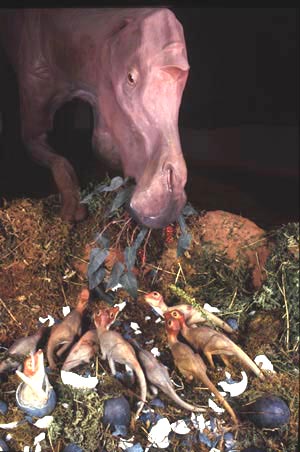"Good Mother Lizard"
Photo courtesy of the Museum of the Rockies There have been some extraordinary dinosaur discoveries in our state over the past few decades, but the fossils that put Montana on the prehistoric map were found near Choteau by paleontologist John Horner beginning in the late 1970s. About 12 miles west of Choteau in an area that includes the famous Egg Mountain site, Horner and friends unearthed colonies of dinosaur nests as well as a bed of bones from a heard of over 10,000 duck-billed dinosaurs thought to have been killed by a volcanic eruption 75 million years ago. These discoveries along with Horner's research have done as much to advance our understanding of dinosaur behavior as any other fossil site in the world. Here are some highlights from the Choteau area discoveries. For a more detailed account of the evidence discussed below, you'll have to read Horner's book, Digging Dinosaurs.
There have been some extraordinary dinosaur discoveries in our state over the past few decades, but the fossils that put Montana on the prehistoric map were found near Choteau by paleontologist John Horner beginning in the late 1970s. About 12 miles west of Choteau in an area that includes the famous Egg Mountain site, Horner and friends unearthed colonies of dinosaur nests as well as a bed of bones from a heard of over 10,000 duck-billed dinosaurs thought to have been killed by a volcanic eruption 75 million years ago. These discoveries along with Horner's research have done as much to advance our understanding of dinosaur behavior as any other fossil site in the world. Here are some highlights from the Choteau area discoveries. For a more detailed account of the evidence discussed below, you'll have to read Horner's book, Digging Dinosaurs.
Good mothers . . .
In 1978 Horner and the late Bob Makela dug up the first nest of baby dinosaurs ever found. In the years to follow many more 6-foot wide nests were discovered. The size of the shells indicated that the babies were about 12 inches long at birth, but bones of much larger infants were discovered in some of the nests. This showed that this species of dinosaur cared for its young, unlike modern sea turtles that lay their eggs in the sand and leave the babies to fend for themselves. The teeth of the infants even showed signs of wear, suggesting that the adults brought food to the nests. As a result, the newly discovered species, a type of duckbilled dinosaur, was named Maiasaura (Greek for "good mother lizard").
Social colonies, nesting grounds . . .
Many of the nests were found at two locations called "Egg Mountain" and "Egg Island". These were small islands when the eggs were laid, yet the dinosaurs kept their nests separated by 23 feet, the approximate length of an adult Maiasaur. This suggests a type of cooperation typical of animals that live in groups. Nests at these two sites were found at three different levels, separated by layers of sandstone. Apparently the islands were nesting grounds that the Maiasaurs returned to year after year.
Term: paleontology
|








